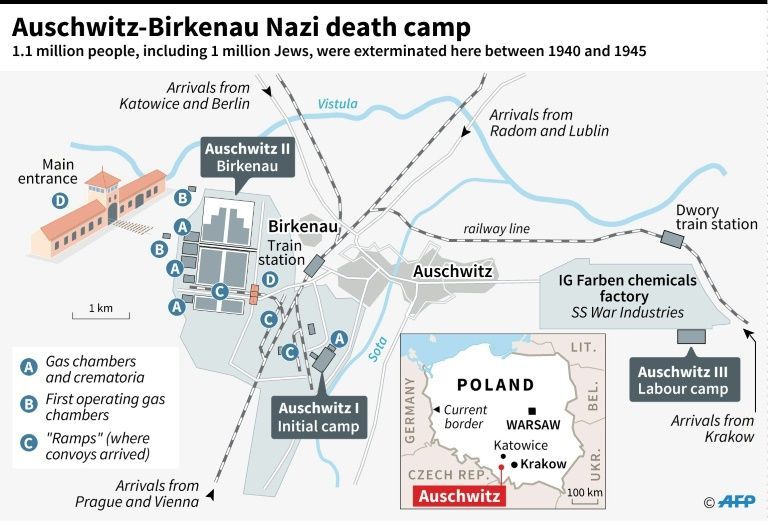The liberation of Auschwitz-Birkenau: Holocaust Remembrance Day
Daily News Article — Posted on January 27, 2021
NOTE: January 27 is International Holocaust Remembrance Day.
(by Deb Kiner, PennLive) — On Jan. 27, 1945, the Soviet Army liberated the Nazi death camp, Auschwitz-Birkenau, in German-occupied Poland.
Soldiers freed more than 7,000 people who had been held at the camp by Nazi Germany. They were starved and tortured.
The Soviets also found piles of corpses and piles of clothing, shoes and human hair removed from people who had been executed in the gas chamber.
The soldiers were not prepared for what they would find, according to history.com.
“They rushed toward us shouting, fell on their knees, kissed the flaps of our overcoats, and threw their arms around our legs,” remembered Georgii Elisavetskii, one of the first Red Army soldiers to step into Auschwitz. After five years of hell, Auschwitz was liberated at last.
History.com reported, “Eva Mozes Kor was 10 years old when she spotted the soldiers. She was one of a group of hundreds of children who had been left behind, and she had endured [terrible mistreatment] during her imprisonment. She remembered how the soldiers gave her ‘hugs, cookies and chocolate. … We were not only starved for food but we were starved for human kindness.’”
Auschwitz-Birkenau is a lasting symbol of the horror of the Holocaust. Millions of people visit it each year to pay homage to the lives senselessly and brutally lost there.
During World War II by mid-January, the Soviet Army was approaching Auschwitz. The SS – Adolf Hitler’s ruthless organization which ran the camps – began destroying evidence and emptying the concentration camp by forcing 60,000 prisoners – mostly Jews – to march west. Prisoners who fell behind were shot. Fifteen thousand people died on the death marches.
According to the United States Holocaust Memorial Museum, thousands of prisoners also were killed in the days prior to the marches.
“It is estimated that at minimum 1.3 million people were deported to Auschwitz between 1940 and 1945; of these, at least 1.1 million were murdered,” according to the museum.
The Holocaust began in 1933 when Hitler came to power. It ended in 1945 when Hitler and the Nazis were defeated.
During the Holocaust, 11 million people died including 1.1 million children. Of those 11 million, 6 million were Jews.
“The Holocaust was the systematic, state-sponsored persecution and murder of six million Jews by the Nazi regime and its allies and collaborators,” according to the museum. “The Nazis came to power in Germany in January 1933. They believed the Germans belonged to a race that was ‘superior’ to all others. They claimed that the Jews belonged to a race that was ‘inferior’ and a threat to the so-called German racial community.”
In 2005, the United Nations General Assembly designed Jan. 27 as International Holocaust Remembrance Day.
Published at pennlive .com. Reprinted here for educational purposes only. May not be reproduced on other websites without permission.
Background
Before the outbreak of World War II, there were an estimated 16.5 million Jews in the world.
- The Holocaust, also known as Shoah (Hebrew “the catastrophe”; Yiddish: from the Hebrew for “destruction”), was the mass murder or genocide of approximately six million Jews during World War II, a program of systematic state-sponsored murder by Nazi Germany, led by Adolf Hitler and the Nazi Party, throughout the German Reich and German-occupied territories.
- Of the nine million Jews who had resided in Europe before the Holocaust, approximately two-thirds were killed.
- Over one million Jewish children were killed in the Holocaust, as were approximately two million Jewish women and three million Jewish men.
- A network of over 40,000 facilities in Germany and German-occupied territory were used to concentrate, hold, and kill Jews and other victims. (from wikipedia)
Remembering the Holocaust:
- January 27 marks the liberation of Auschwitz – the Nazi death camp – in 1945. It is also designated International Holocaust Remembrance Day. It was designated by a United Nations General Assembly Resolution in 2005. The resolution came after a special session was held earlier that year, on January 24, 2005 during which the UN General Assembly marked the 60th anniversary of the liberation of the Nazi concentration camps and the end of the Holocaust. This day is also a national event in the United Kingdom and in Italy. (Read more at wikipedia)
- Yom HaShoah (Holocaust Remembrance Day) is observed as Israel’s day of commemoration for the approximately six million Jews who perished in the Holocaust as a result of the actions carried out by Nazi Germany. In Israel, it is a national memorial day. It was inaugurated in 1953. It is held on the 27th of Nisan (April/May), unless the 27th would be adjacent to Shabbat, in which case the date is shifted by a day.
- Some other countries have different commemorative days for the same event: wikipedia.org/wiki/Holocaust_Memorial_Days.
- Yad Vashem (“Holocaust Martyrs’ and Heroes’ Remembrance Authority”) is Israel’s official memorial to the Jewish victims of the Holocaust established in 1953. The origin of the name is from a Biblical verse: “And to them will I give in my house and within my walls a memorial and a name (Yad Vashem) that shall not be cut off.” (Isaiah 56:5).

